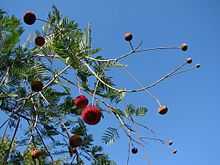Parkia
From Wikipedia, the free encyclopedia
| Parkia | |
|---|---|
 | |
| Parkia platycephala | |
| Scientific classification | |
| Kingdom: | Plantae |
| (unranked): | Angiosperms |
| (unranked): | Eudicots |
| (unranked): | Rosids |
| Order: | Fabales |
| Family: | Fabaceae |
| Subfamily: | Mimosoideae |
| Tribe: | Parkieae |
| Genus: | Parkia Robert Brown |
| Type species | |
| Parkia biglobosa R. Wight and G. Arnott | |
| Species | |
|
See text. | |

Parkia pendula - MHNT
Parkia is a genus of flowering plants in the legume family, Fabaceae. It belongs to the subfamily Mimosoideae.
In 1995, about 31 species were known.[1] Four more have been discovered since that time.[2] The type species for the genus is Parkia biglobosa.
Parkias are found throughout the tropics, with four species in Africa, about 10 in Asia, and about twenty in the neotropics. The neotropical species were revised in 1986.[3]
Species
- Parkia barnebyana
- Parkia bicolor
- Parkia biglobosa - néré
- Parkia biglandulosa
- Parkia filicoidea
- Parkia javanica
- Parkia lutea
- Parkia madagascariensis
- Parkia nana
- Parkia paya
- Parkia platycephala
- Parkia speciosa - petai, twisted cluster bean, stink bean
- Parkia timoriana - tree bean

Parkia biglandulosa inflorescence , taken at AC&RI, Killikulam, India
References
| Wikimedia Commons has media related to Parkia. |
- ↑ Melissa Luckow and Helen C.F. Hopkins. 1995. "A cladistic analysis of Parkia". American Journal of Botany 82(10):1300-1320.
- ↑ David A. Neill. 2009. "Parkia nana (Leguminosae, Mimosoideae), a New Species from the Sub-Andean Sandstone Cordilleras of Peru". Novon 19(2):204-208. doi:10.3417/2007152
- ↑ Helen C.F. Hopkins and Marlene Freitas Da Silva. 1986. "Parkia (Leguminosae: Mimosoideae) (Flora Neotropica Monograph No. 43) with Dimorphandra (Caesalpiniaceae) (FN Monograph No. 44)". In: Flora Neotropica (series). The New York Botanical Garden Press.
This article is issued from Wikipedia. The text is available under the Creative Commons Attribution/Share Alike; additional terms may apply for the media files.